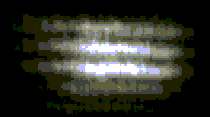What retinal area scans text when central
vision is lost?
Sharma MK1, Timberlake GT1,2, Gobert D1,2 , Schuchard RA3, Maino JH1,2
1Kansas
City VA Medical Center, 2University of Kansas Medical Center, 3Atlanta
VA Medical Center
Objective: When normally sighted individuals
read, high-speed saccadic eye movements shift text characters onto the
retinal area of highest acuity, the fovea, where they are "inspected"
and processed. When foveal vision is lost due to macular disease, many
people are still able to read (slowly) using a peripheral retinal area.
The retinal location of this peripheral "text scanning area"
is not known and cannot be deduced from eye movement recordings. Our objective
was to determine the retinal area used to scan text by digital image analysis
of Scanning Laser Ophthalmoscope (SLO) video images that show text on
the retina during reading.
Methods: Participants with normal vision
or with bilateral macular scotomas read simple three-line sentences presented
in the SLO. Videotaped images showing text on the retina during reading
were digitized. Retinal "text maps" were created by measuring
the coordinates (in pixels) of a retinal vessel landmark in each video
frame. The coordinates were then used to shift a white-on-black image
of the text. After each shift, grayscale values were added. In the resulting
image, bright regions correspond to retinal areas on which text was placed
most frequently; darker regions correspond to areas on which text was
infrequently placed (see inset). Final retinal maps show areas used for
text scanning and for fixating a small target.
Results: As expected, the brightest area
of the text map corresponded to the central fovea for normally sighted
subjects. Their retinal text maps also showed a highly ordered five-line
structure, a result of scanning three text lines. Subjects with central
visual loss all used a unique peripheral retinal area to scan text characters.
In some instances, the brightest area of the text map corresponded to
the retinal area the subject also used to fixate small visual stimuli.
In other instances, the fixation area and text scanning area did not correspond.
Retinal text maps of those with central visual loss lacked the orderly
five-line structure, were larger, and less distinct than those of normal
readers.
 (Sharma)
(Sharma)
Conclusions: We have shown that the retinal
area used to scan text during reading can be accurately delineated using
SLO retinal text maps. These maps are equivalent to a photographic time
exposure in which the retina is the "film." Subjects without
foveal vision use a consistent, unique retinal area to scan text. This
area is not always the same as the area they use to inspect small, stationary
objects. Rehabilitation specialists who wish to improve the reading abilities
of patients with macular disease may find it useful to understand the
retinal location a patient uses for scanning text in relation to the scotomatous
area of central visual loss.
Funding Acknowledgment: Supported by VARR&D
Grants C838-RA & C1740R.
 (Sharma)
(Sharma)